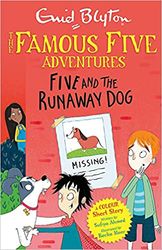Thanks to Enid Blyton, I travelled to all sorts of imaginary places in my childhood—enchanted forests with pixies and fairies; animal farms and bedrooms where toys came alive at night; Malory Towers, the castle-like boarding school of lacrosse games, cliff-top rescues and midnight feasts…. Each of Blyton’s book series serenaded different phases of my life, from the adventures of Brer Rabbit, which my mother read to me when I was little more than a toddler, to the Noddy series, which helped lessen my loneliness when I first joined boarding school in the third standard.
And then there was the Famous Five—how I envied Julian, George, Dick, Anne and Timmy their adventures. Here I lived my insipid life of math and science classes, while they traipsed off to Kirrin Island each summer—to a world of ruined castles, hidden treasures, circling jackdaws and tall glasses of ginger-beer. A world that was foreign to me—full of strange words like ‘Golly’ and ‘Buck up’—and yet more familiar than my own world. After all, I spent much of my childhood in it, ribbing Dick for his prodigious appetite, kicking Anne under the table for her gaffes and feeding Timmy crumbs of scones.
For thousands of children all over the world, the Famous Five books were an antidote to their loneliness. That is why British-Indian children’s writer Sufiya Ahmed had no easy task recreating the series for a modern audience. An entire generation’s childhood was pinned on Blyton’s books and now, Ahmed was assuming the mantle.
She was commissioned by Hachette, who owns the rights to Blyton’s books, to write a four-part ‘Famous Five colour short stories’ series, two of which are already out. “Whether it is Famous Five, the Secret Seven or the girls at Malory Towers, these are beloved characters and I am just making the setting for their adventures more reflective of the world that young readers live in, without changing the essence of their appeal,” she says.
In the books, she adds a cast of secondary characters. People of colour who live in Kirrin village are depicted in the illustrations. The third book, Five and the Message in a Bottle, includes a police chief of Nigerian heritage. A woman and a girl in hijab are also featured in background images as village residents. In the second book, Five and the Runaway Dog, Simi is a young girl of South Asian heritage the five try to help. Her family has just opened a bakery that sells Indian sweetmeats which are hungrily sampled by the five. “This is all reflective of modern Britain,” says Ahmed. “A young reader sees the Britain they are familiar with, one that is multicultural and inclusive.”
For Ahmed, a winner of the Redbridge Children’s Book Award, this desire to give voice to South Asian characters has resulted in two books with South Asian heroines—My Story: Princess Sophia Duleep Singh and My Story: Noor-Un-Nissa Inayat Khan. “The stories of Noor and Sophia are about our shared history and I feel they can add to the sense of belonging for British South Asians to our home country,” says Ahmed, whose latest book, Rosie Raja: Churchill’s Spy, released on August 4. Although she was born in Gujarat, she moved to London at the age of four. A voracious reader, Ahmed devoured the books in her library, especially those by Blyton and Roald Dahl, both of whom played a seminal part in her becoming a children’s book writer. Her debut, Secrets of the Henna Girl, was published by Puffin Books in 2012.
However, unlike narrating the stories of South Asian heroines, flavouring the Famous Five with an oriental touch is a different ballgame altogether. Ahmed is treading on sacred ground. Next to Shakespeare and Agatha Christie, Blyton is the third most translated author in the world. In Britain, she is the seventh most borrowed author from public libraries. Blyton’s grip on a child’s imagination was vice-like. She was the enchantress who could rustle up a delicious treacle pudding for little girls on distant shores who had no idea what a treacle pudding was. But knew it must be good because four British children loved it. And a madcap dog wagged his tail at its mention.



